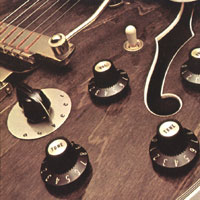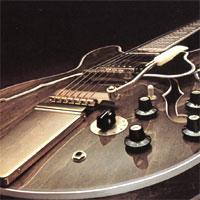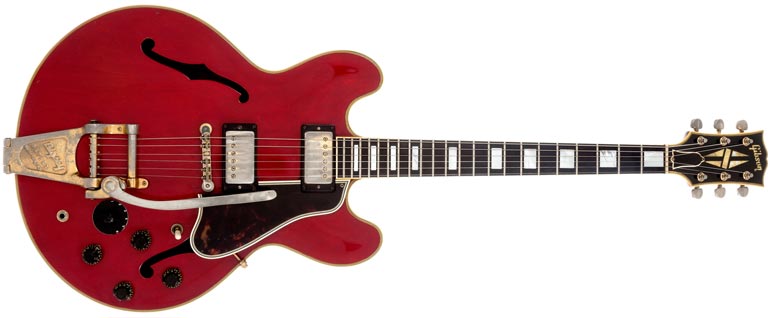
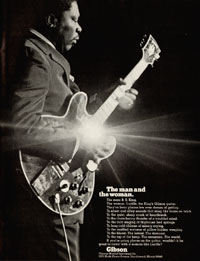
Gibson advert from 1972 BB King plays his Gibson ES-355 TDSV - The Man and the Woman
By the 1970s this guitar was so heavily associated with BB King that he was featured in numerous Gibson advertising campaigns and on the front cover of the 1975 catalogue (below) more about BB King and his ES-355-TDSV
Other famous users include Chuck Berry, Freddie King and Alex Lifeson of Rush
check out pictures of ES355 in action
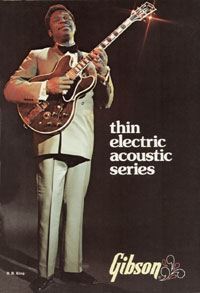
The Gibson ES-355TD SV is a variation on the Gibson ES355 or ES-355TD guitar (ES standing for Electric Spanish, and TD Thinline Double cutaway) with the addition of Stereo output and six-position Varitone (SV).
The 355 was the top of the line 300-series Gibson. Although it featured the same basic construction of the Gibson ES-335TD and Gibson ES-345TD, it was fitted with a vibrato, stereo circuitry and beautifully appointed with gold-plating throughout, block position marker inlays and the famous split diamond headstock inlay.
It was a popular guitar, first shipping in 1959 (see ES-355TD-SV shipping statistics here), and one largely associated with blues artists, specifically Chuck Berry and BB King. It was, though, considerably more expensive than other thinline ES guitars - see the timeline below for pricing changes over the course of production.
Like any Gibson guitar with a long production run, it changed somewhat over the time it was produced, primarily in terms of hardware and finish options, but the basic rationale and functionality remained constant. This guitar was never inexpensive, and today vintage Gibson ES-355s are highly prized and equally highly priced guitars.
The following description is taken from the 1966 Gibson catalogue
This magnificent stereo jazz guitar reflects all the beauty and skill of the guitar maker's art. With tone ranging from a clear treble to a throaty bass, with thrilling vibrato and instant response, it offers the accomplished artist a truly amazing range of sound. The Gibson Vari-Tone control provides six preset tonalities. The ES-355TD-SV stereo guitar can be played through a stereo amplifier, two channel amplifier or two separate amplifiers. Special stereo wiring and "Y" cable provide complete separation of tone.
and this comes from the 1970 Gibson thinline catalogue
A magnificent stereo guitar with bound "f" holes, the ES-355TD-SV offers the accomplished artist an amazing range of sound. Tone ranges from a clear treble to a husky bass - with thrilling vibrato and instant response. It can be played through a stereo amplifier or two separate amplifiers. Special stereo wiring and "Y" cable provide complete separation of tone.
ES-355TD-SV features and specifications
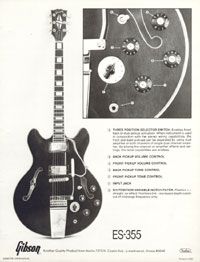 1978 spec sheet for the ES-355TD-SV
1978 spec sheet for the ES-355TD-SV
- Curly maple top, back and rims (rims are spruce after 1980) with solid maple centre block
- Slim, fast, low-action neck joins body at 19th fret (1958-1962) and from then on at the 20th fret
- One-piece mahogany neck (1958-1969?) Laminated maple neck (1970-1982)
- Ebony fingerboard, pearl block inlays
- Gold plated hardware throughout
- Tune-O-Matic bridge
- Twin Humbucking pickups with separate tone and volume controls
- Three position toggle switch
- Vibrato tailpiece. Bigsby / Maestro and TP-6 from 1979/80
- Six-position Vari-Tone control
- 16" wide, 19" long, 1 3/4" thin; 24 3/4" scale, 22 frets
The varitone gave increasing depth notch out of midrange frequency. An explanation of all controls can be seen in the ES-355 control description sheet, issued in 1978
Gibson ES-355 finish options
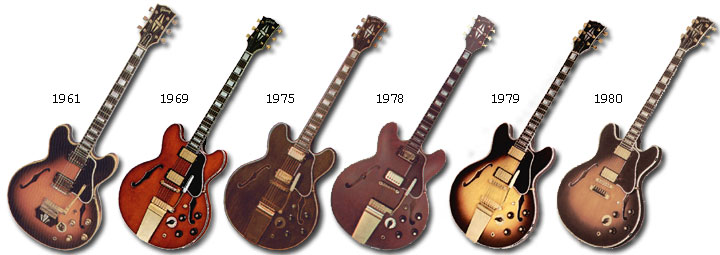
The Gibson ES-355 TD SV was available in several standard finishes, as well as a number of custom colors. From left to right; 1961 sunburst, 1969 cherry, 1975 walnut, 1978 wine red, 1979 sunburst, 1980 antique sunburst. The very first 355s were fitted with a Bigsby vibrato/tailpiece as standard. This was offered throughout the 1960s at a significant premium. Note the ebony block tailpiece which occured in some early sixties models, and the TP-6 tailpiece of the newest instrument.
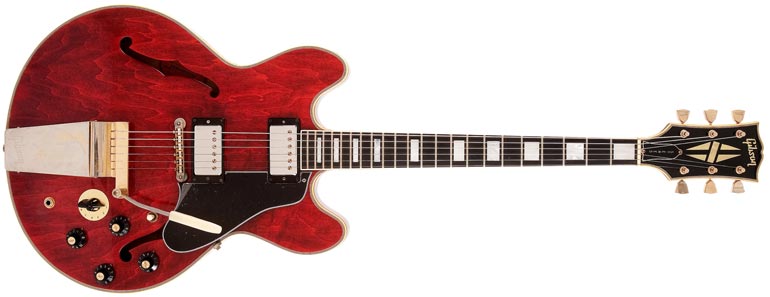
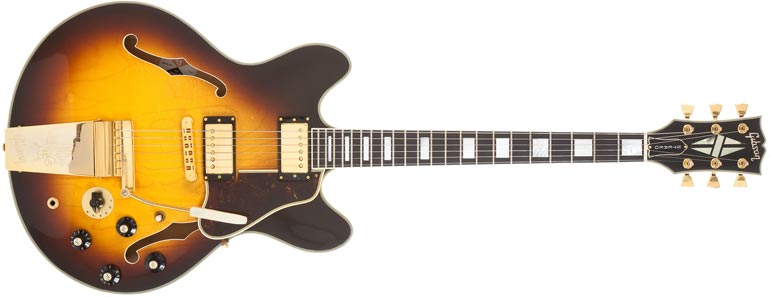
1969 Gibson ES-355TD-SV (Cherry) and and 1979 Gibson ES-355TD-SV (Antique Sunburst)
Image Heritage auctions
Gibson ES-355TD-SV chronology
1958 ES-335 launched in August, the ES-355 (non varitone) about 2 months later
[1]. 10 Instruments shipped in 1958
[2]. Bigsby vibrato. Cherry finish as standard
1959 First stereo varitone instruments shipped
[2]. 1959 price lists list mono and stereo varitone guitars as the ES-355TD; the stereo version is listed at $600
[3]. Cherry finish only.
1960 The
1960 Gibson catalogue is the first to include the ES-355TD-SV - shown with the side to side vibrato. US price still $600.
1961 Price rises from $600
[4] to $645
[5]
1962 The
1962 catalogue uses the same image and description as the previous catalogue. Price still $645
[6]
1963 Gibson deluxe vibrola. Price rises from $645
[7] to $680
[8]
1964 The 355TD-SV also graces the cover of the
1964 Gibson electrics catalogue. Price rises to $720 towards the end of the year.
[9]
1965 Prices remain unchanged into 1966
[10-12]
1966 The
1966 catalogue is the first to show this model in colour. Price rises to $775 in October
[13]
1967 Price rises to $800 in September
[14]
1968 Price rises significantly to $865
[14]
1969 Sunburst and Walnut finishes available. Another price increase, now $915
[15]
1970 Sunburst finish withdrawn. $915
[16], rising to $925 by the second price list of the year
[17].
1971 Price rises from $925 in the middle of the year
[18] to $945 by November
[19]
1972 The ES-355TD-SV is included in Gibson's "guitar of the month" showcase series - a separate brochure for each model in the series. Price rises from $945 in the September list
[20] to $965 in October
[21]
1973 List price $985
[22]
1974 Initial price for the year unchanged at $985
[23], rising to $1085 in May
[24]
1975 Cherry finish is replaced by 'Cherry wine' which is renamed in '77 as 'wine red'. BB King plays a walnut 355 on the cover of the
1975 Gibson thinline catalogue. This year the price dropped, initially to $999
[25-26], though rose again by the end of the year, but to $1039
[27] where it stayed throughout 1976
[28-29]; lower than the final 1974 price.
1977 The price rises above the late '74 level for the first time - $1099
[30]
1978 Sunburst and antique sunburst finishes available
[31]. US list price rises to $1149
[32]
1979 Vibrola replaced with the TP-6 tailpiece. US list price rises to $1229 at the start of the year
[33-34] and again to$1299 by the end of September
[35]
1980 1980 Gibson literature describes the usual ES-355TD-SV, but also a new variant with mono/stereo circuitry but no varitone switch - this briefly available model is called the ES-355TDS/79. Listed in the United States at $1349 and $1299 respectively
[36-37].
1981 The
1981 Gibson/Rosetti catalogue was produced for the UK market right at the end of 1981. It shows the ES-355TD-SV alongside the new BB King signature models. The final price list entry only includes the stereo varitone model, with another big price increase at $1549
[38].
1982 Model discontinued, superceded by the
BB King Custom.
- The Gibson Guitar by Ian Bishop
- Gibson Shipment Totals by Larry Meiners
- Gibson pricelist 1/11/1959
- Gibson pricelist 1/6/1961
- Gibson pricelist 1/9/1961
- Gibson pricelist 1/10/1962
- Gibson pricelist 15/7/1963
- Gibson pricelist 1/9/1963
- Gibson pricelist 1/9/1964
- Gibson pricelist 1/2/1965
- Gibson pricelist 22/6/1965
- Gibson pricelist 1/4/1966
- Gibson pricelist 1/10/1966
- Gibson pricelist 1/9/1967
- Gibson pricelist 1/9/1969
- Gibson pricelist 1/3/1970
- Gibson pricelist 1/9/1970
- Gibson pricelist 26/6/1971
- Gibson pricelist 22/11/1971
- Gibson pricelist 1/9/1972
- Gibson pricelist 15/10/1972
- Gibson pricelist 1/6/1973
- Gibson pricelist 1/2/1974
- Gibson pricelist 1/5/1974
- Gibson pricelist 1/1/1975
- Gibson pricelist 20/6/1975
- Gibson pricelist 1/11/1975
- Gibson pricelist 1/3/1976
- Gibson pricelist 1/6/1976
- Gibson pricelist 1/1/1977
- Gibson 1978 full-line catalogue
- Gibson pricelist 15/5/1978
- Gibson pricelist 1/1/1979
- Gibson pricelist 1/6/1979
- Gibson pricelist 30/9/1979
- Gibson pricelist 7/1/1980
- Gibson pricelist 1/7/1980
- Gibson pricelist 1/4/1981
Got an opinion on the contents of this page? Disagree with something written above? Please
comment


